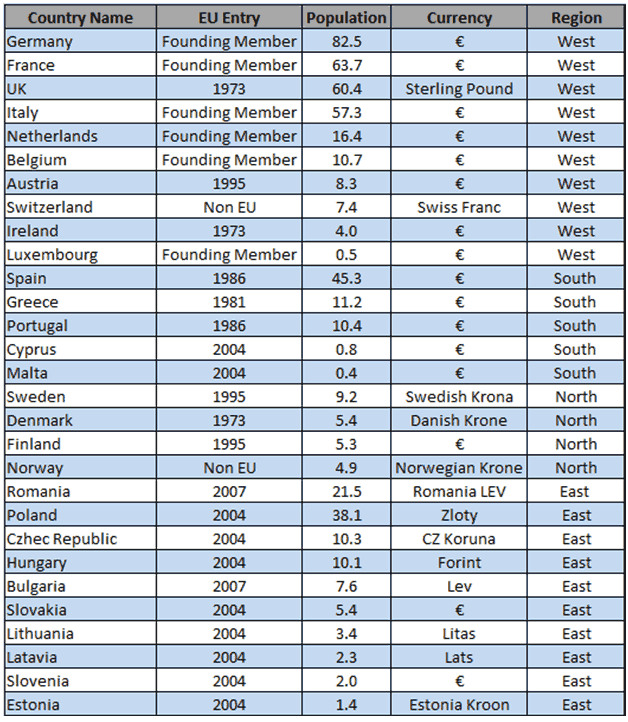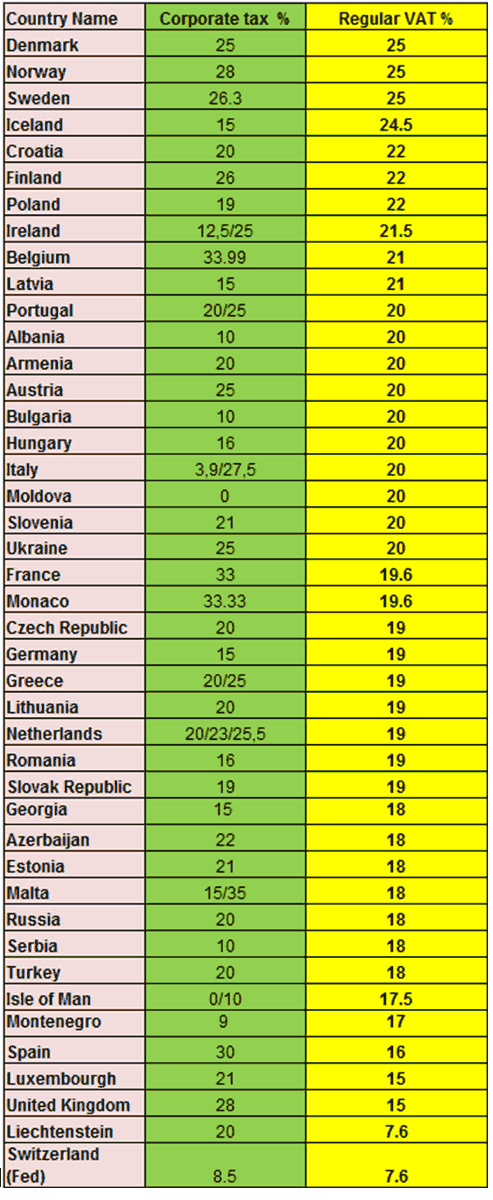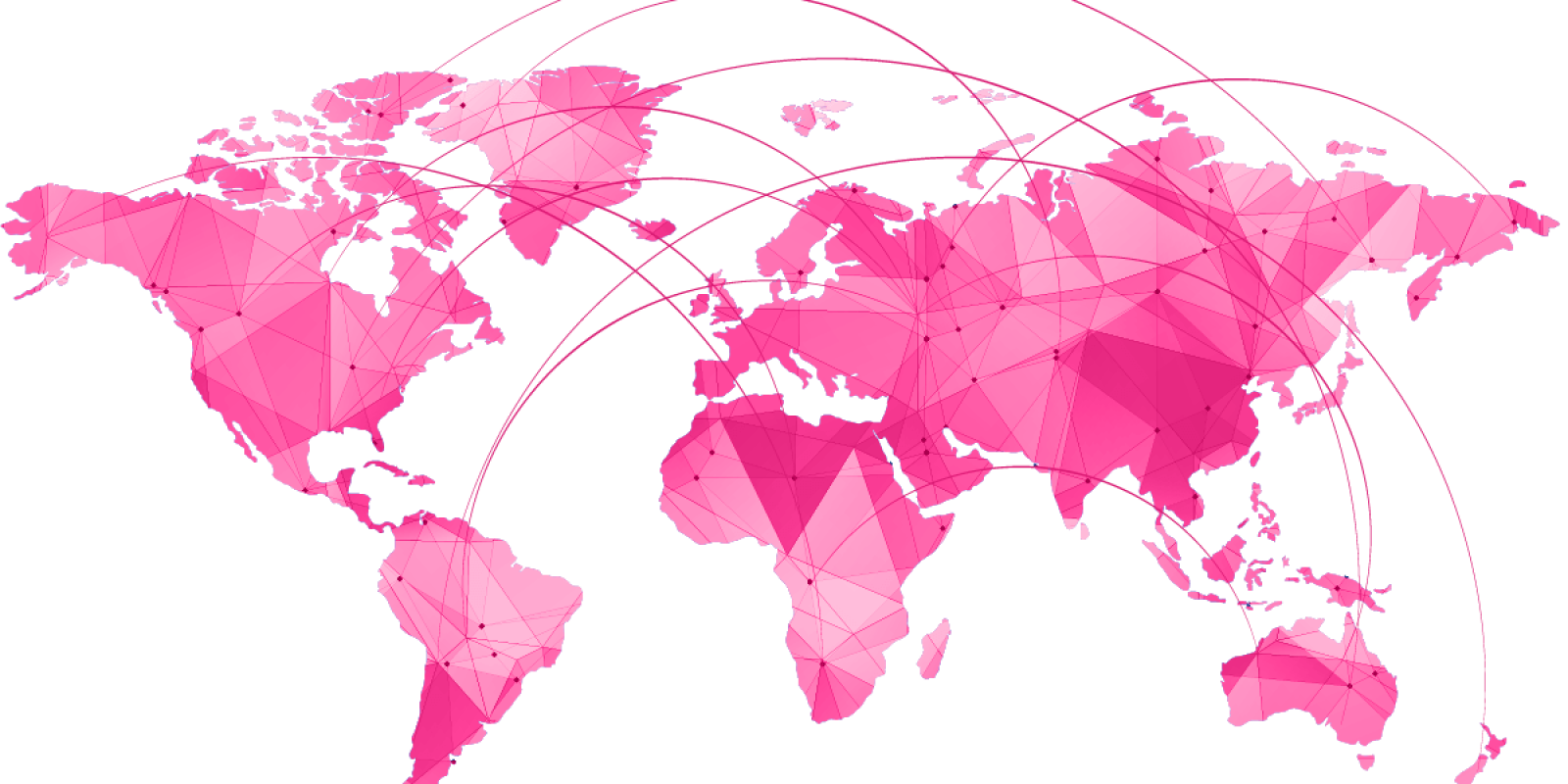I have spent the last 4½ months in Europe developing a Supply Chain Strategy for a Global Company that distributes widgets in Western, Southern and Northern Europe. During this time, I became immersed in the culture and business practices of the region. Now that I am back in the States, it is especially apparent to me that Europe is faced with different cultural, language and infrastructure challenges compared to the U.S.
I have provided a simple table below that illustrates the geographical region and background information on each of the countries in the European Union (EU). (Although, Norway and Switzerland are not part of the EU and most likely never will be- unless Norway’s oil reserve dries up and the Swiss decide get out international banking). The Union is made up of many countries with unique cultures, languages and business infrastructure. This presents clear business challenges to the region, especially within supply chain.
In the table below the population for each country may be slightly out-of-date, but what is important is the relative size of the population compared to other countries. Population size also provides insight into the size of the consumer market.

I don’t claim to be an expert on European Supply Chains but over the last 4 ½ months and now my third European Supply Chain design in seven years, I have learned and experienced a lot. Over the last seven years I have seen significant changes in Europe. Additional countries have joined the EU. Countries are slowly but surely building out logistics infrastructure. Most of all, European countries are starting to realize that in order to be competitive, they must act as ONE. The economy, global competition, and market conditions have taken a toll in Europe. In the past, the mission of Think Globally and Act Locally has only been a tagline within Europe, without real execution. Companies in Europe are now acting on this mission. They don’t have a choice.
Culture & Language
Americans struggle sometimes with how to define our culture. Our 250-year old culture is still taking shape and maturing, whereas European countries draw from cultures that date back over 2,000 years. Thus, the culture is much more ingrained into the rhythm of life and business and into the attitudes of their people.
During my most recent stay, I spent the majority of my time in Germany, Spain, Italy, Denmark, Slovakia and Belgium. While in Germany, I made camp in a small city called Trier. The Romans built Trier in approximately 180 AD; Trier was the largest Roman Empire North of the Alps. Today there are numerous historical Roman artifacts in Trier: Porte Negra, the Coliseum, and numerous bath houses. The people of Trier are proud of the fact that they live in the oldest city in Germany. There is a strong and rich legacy that strongly influences attitudes and practices.
As an American visitor in Trier and throughout Europe, I clearly felt the distinct and rich heritage of art, architecture, food, language, religion, and family ties and tradition. Now consider how the culture of each country influences business practices. Instead of one universal language in the EU, there are many different languages and dialects. There are long-standing alliances and discord between countries. And there are different mindsets that all weave together to create a colorful, and sometimes difficult patchwork in which to conduct business. Americans sometimes have a mentality of “what is good for the U.S. must be good for Europe.” Clearly however, the business landscapes are distinctly different, and must be treated accordingly. Americans need to keep an open mind and consider culture and language differences when designing a European Supply Chain.
Infrastructure
In Europe there is perception and reality that business is conducted within Country and you cannot conduct business across borders. Many global and international companies are set up with independent operating business units in each country because of language and cultural variances. Does this matter when it comes to designing a European Supply Chains? The answer is yes.
Unfortunately many companies, as a result of acquisitions, mergers, or go to market strategy, have established independent or decentralized supply chain networks to support the local business climate. It is not uncommon for a company to have different sales, administration support, and warehouses spread throughout Europe in order to service their local customer base. Many customers (Retail and Wholesale) expect that a Distribution Centric supplier and organization have in country stock and can service their needs by the next business day (17:00). I believe the last time I completed a U.S. network analysis where the client needed next-day coverage using a ground parcel network, the company had to have seven distribution centers (covering all 42,000+ US Postal Codes). You may be thinking it is simple, Europe is not that big. And you’re right, Europe is not that big compared to the U.S., but there are a number of infrastructure and tax challenges that must be considered when doing business in Europe.
It is a fact that Europe as a whole is 10+ years behind the U.S. when comes to supply chain infrastructure, and in some cases, countries are 20+ years behind. I define supply chain infrastructure as air, rail and road networks, transport carrier coverage (all modes), supply chain execution technology, open trade policies (VAT Exempt), and free circulation of goods.

Increase ROI Through Successful Warehouse Slotting
A well-thought-out slotting strategy also enables businesses to minimize wasted space and maximize storage capacity within the warehouse. Increase ROI using the right tools, strategy and management plan with successful warehouse slotting.
Two weeks ago I spent two full days with two of the larger parcel carriers in Europe (DPD and UPS). Meeting with each carrier validated my assumption about the logistics and technology infrastructure across Europe. UPS started their European operation in 1976 within Germany. This makes sense since Germany has the largest population and largest GDP within Europe. (For comparison purposes, imagine that UPS started their U.S. operations in California). The UPS European network was designed to optimize Germany, not Europe. This is not stay that UPS does not service other countries because they do. However, when UPS designed their network they designed their parcel network to optimize “in country” shipments versus all of Europe. Their major ground hub, which was built in Frankfurt, came online about 10 years ago. Similar to the U.S., UPS Europe utilizes a hub and spoke network, therefore packages most likely going through Frankfurt for sortation. UPS admits that had they had the opportunity to design a European Ground Network from scratch it would look entirely different. UPS by far has the strongest technology in Europe compared to their competition, and more importantly, it uses the same technology solution for all shipments within Europe.
In contrast to the U.S., European Parcel Carriers do not use zone & weight based pricing. Only a handful LTL carriers use tariffs. If you have ever negotiated a LTL or Parcel contract in the U.S., you understand the complexities. In Europe, these shipments are charged a flat rate, regardless of distance, but rates do include weight breaks.
DPD is an interesting company. The French Post owns approximately 86% of DPD. DPD is a non-asset based carrier that uses sub-contractors and an extensive franchise network to deliver their parcels. Unlike UPS, they use a “dynamic” ground network which is a fancy way to say that they have numerous depots and hubs and they ship point to point (line haul) from any depot to any depot. The advantage to their network is that they can improve both cut-off times and transit times. Although DPD is extremely competitive on pricing, you get what you pay for. If you are shipping cross0 border, you will be dealing with multiple entities and technology platforms.
I use the example of DPD and UPS to illustrate that even two of the largest parcel carriers in Europe do not provide a Total European Solution. To further validate the lack of infrastructure in Europe, I challenge anyone to find a parcel and LTL execution system that can execute rating, routing and carrier compliance labeling within Europe. I am not referring to a Transportation Management System, I am referring to a simple parcel/LTL execution system. In the U.S., we have numerous options: Kewill, Connect Ship, Logicore, Varsity Ship, and wide number of U.S. based WMS providers. In Europe it is a different game. There are companies that have “in country” solutions but there is not ONE solution provider that has a system that effectively complies with all of Europe.
The European Union (EU) was established to open up free trade between its members and allow free trade between countries, much like NAFTA. The reality is that each country wants a cut of the trade and they do this through a Value Added Tax (VAT). I have provided a VAT table below. The VAT laws in Europe are complex. I suggest that if you are going to ship cross-border (even within the EU), hire a VAT lawyer. Ultimately some participant in the source to consumption supply chain is going to pay the VAT.

In summary, when designing a European supply chain network there are many factors that must be considered, including: cost, service, inventory and risk. Regardless if the network design is for Europe or the United States always develop value stream maps from the customer backwards. However, a European network design provides challenges beyond cost and service. In a continent of diverse cultures and languages, humility, an open mind and willingness to learn will get you a long way. Of course, this practice will get you a long way in life in general too.
Always in Motion,
Jim Barnes






